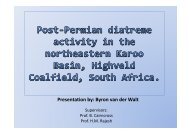coaltech upper olifants river catchment wetland inventory ...
coaltech upper olifants river catchment wetland inventory ...
coaltech upper olifants river catchment wetland inventory ...
You also want an ePaper? Increase the reach of your titles
YUMPU automatically turns print PDFs into web optimized ePapers that Google loves.
o The Fish Assemblage Integrity Index (FAII);<br />
o The Riparian Vegetation Index (RVI); and<br />
o The Index of Habitat Integrity (IHI).<br />
SASS 5 uses the specific habitat requirements of invertebrates, including snails, crabs,<br />
worms, insect larvae, mussels and beetles, to assess the overall condition of a <strong>river</strong> system.<br />
Most invertebrate species are short-lived, the changes in <strong>river</strong> condition are therefore,<br />
displayed accurately by the species composition. The SASS 5 results are expressed as an<br />
index score and as an average score per taxon (CSIR 2001).<br />
The FAII is an index using fish as an indicator of <strong>river</strong> health. Fish are long-lived and are<br />
therefore, indicators of long-term changes in the <strong>river</strong> health. The index categorise fish<br />
populations according to their intolerance to changes in habitat and pollution. The results are<br />
expressed as a ratio of the observed conditions to the expected conditions without human<br />
impact. The system is currently being utilised, but is also being refined to ensure greater<br />
accuracy (CSIR 2001).<br />
The RVI focuses on the health of the riparian zones of <strong>river</strong>s. Various impacts including the<br />
collection of firewood, changes in the flow regime and grazing or cultivation practices in the<br />
riparian zone can change the characteristics of the zone. A number of criteria are used to<br />
assess the riparian vegetation including vegetation removal, cultivation, construction,<br />
inundation, erosion, sedimentation and alien vegetation. The health of the riparian zone is<br />
then expressed as a percentage of change from the natural conditions (CSIR 2001).<br />
The greater the diversity of available habitat in and around streams, the greater the species<br />
diversity that can be expected in a <strong>river</strong> system. Different habitat types that can be expected<br />
include pools, rapids, sandbanks, stones in the <strong>river</strong>bed and riparian vegetation. The IHI is<br />
an index that assesses the available habitat in a <strong>river</strong> or stream, and the impacts of human<br />
activities such as water abstraction, flow regulation, and bed and channel modification. The<br />
index includes the status of both the riparian and in-stream habitats (CSIR 2001).<br />
Table 5. According to the National River Health Programme (2001) the <strong>river</strong> health in<br />
the UORC can be defined as follows:<br />
Ecoregions 7.02, 7.04 Ecoregions 2.08 and 2.09<br />
Riparian Habitats Fair to Unacceptable Good<br />
General Condition Poor to Fair Bronkhorstspruit: Good to Fair<br />
Wetland Database for UORC - 55 -




